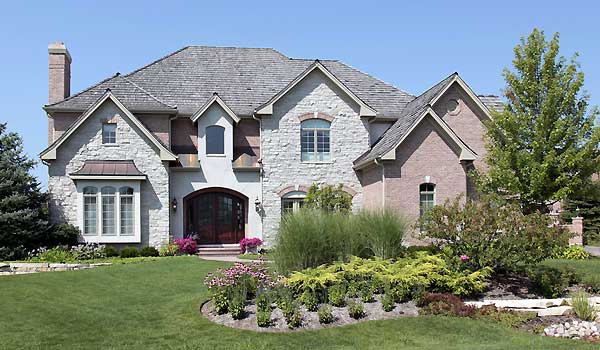Sidewalks For Curb Appeal If you don't already have a sidewalk, you may want to…
Sidewalk Maintenance and Safety Tips For Your Home

There are many types of sidewalks and they all provide a very important function. They are beautiful elements of the landscape of any home or business. They add character and design to the environment and are visually appealing – especially when they are well-maintained.
Sidewalks require some maintenance to retain their beauty and functionality. Many sidewalks are constructed of stone, brick, concrete, or rubber pavers. Some require more maintenance than others. So if you are considering the installation of a sidewalk, be sure to look into the maintenance requirements to see what’s needed on an ongoing basis.
Sidewalks are easily maintained, and they will last much longer if care is taken to inspect them on a routine basis. The sooner you are able to identify potential problems, the quicker you can resolve them. You’ll not only save your sidewalk, but you’ll save yourself some time and money in the long-term too.
Today’s sidewalks are no longer just for functionality. They are part of the overall design and aesthetic appeal of the landscape and the home or business. Keeping them visually appealing is part of the maintenance plan. Older, worn sideways can be easily replaced or upgraded with many of today’s new products and materials. Overlays, concrete stamping, and many other options are available to upgrade the appearance and quality of sidewalks.
If you have a sidewalk, or are considering installation of one, it’s important to understand what is required to maintain the products you choose. Different types of sidewalks require different types of maintenance and materials, so be sure you are willing and able to do what is necessary to retain the functionality and beauty of the sidewalk you choose. You’ll be glad you invested the time and effort in your evaluation of products.
Sidewalk Care and Maintenance
Sidewalks do require some maintenance to keep them visually appealing and functional at the same time, but without the proper maintenance and care, they can also be an eyesore. Unfortunately, poorly maintained sidewalks can be a hazard to children, older adults, and anyone else who may trip or fall on cracks or debris left unkempt. Pay attention to your sidewalks and give them a periodic clean and maintenance check.
Sidewalks typically receive a lot of foot traffic, although some receive more than others. A sidewalk to the front door may not get as much traffic as its sister-sidewalk leading to the back door. But both sidewalks needs some care and maintenance on a routine basis.
Different types of sidewalks require different types of maintenance and materials, so be sure you are willing and able to do what is necessary to retain the functionality and beauty of the sidewalk you choose. Many sidewalks are constructed of stone, brick, concrete, or rubber pavers. Some require more maintenance than others, so if you’re just considering the installation of a sidewalk, be sure to look into the maintenance requirements to see what’s needed on an ongoing basis.
Finally, the old-fashioned sidewalks of those long-gone days are a nostalgic sight. Cracks and crevices with wild grass and dandelions growing sporadically through them and depressions and upheavals in the concrete abound. But for today’s homeowner, a sidewalk like this is a sidewalk in major disrepair! It’s time to think about replacing it.
Maintenance Tips for Sidewalks
There are several things to take into consideration when it comes to sidewalk maintenance. Review the following tips on maintenance and care of your sidewalks:
1. Repair cracks and crevices as soon as they appear to avoid further damage and injury. Replace damaged pavers or repair sidewalk cracks when they become visible or are detected. The sooner you repair, the less costly it will be.
2. Sweep sidewalks frequently as needed to make sure that debris, loose dirt, rocks, gravel, and other material are cleared away. These things can cause erosion or falls. They can work down into the cracks of the sidewalk and cause larger cracks.
3. Keep the sidewalk clean and clear of dust and debris by sweeping or blowing it away with a leaf blower. This will keep the sidewalk in better condition. Keeping the sidewalk clean is a good maintenance tip and it also keeps it looking better at the same time. When you pull out the leaf blower, be sure to blow the sidewalk too. You can also vacuum sidewalks with a shop vac if available.
4. Washing or rinsing the sidewalk periodically with a standard garden hose is recommended to remove tiny particles of dust and sand that become lodged in pavers or seams. But don’t allow water to stand on sidewalks. Especially, after a heavy rain, snow, or ice storm, sweep the sidewalk clean and clear. Removing water is a good way to prevent damage to the surface.
5. Some sidewalks are prone to stains and spots. Oil, dirt, salt, and chemicals that are used during cold weather can stain sidewalks. Stains and spots can be removed with specially formulated stain removal or cleaning products available at most all home improvement stores. Use the correct type of product depending on the type of sidewalk. Check them out and remove and clean sports or stains as soon as they appear.
6. Use environmentally friendly products to clean and repair your sidewalks – this is good citizenship!
7. Trim bushes or shrubbery that may be hanging over sidewalks to keep them clean and clear. In some instances, you may have to remove shrubbery or trees if the roots are growing underneath the sidewalk, causing cracks and irreparable damage.
8. Depending on the type of surface, you may want to consider sealing the sidewalk. There are various types of sealants for different types of sidewalks such as concrete or asphalt. Check out the sealants that are best for your sidewalk and use them as directed.
Sidewalks are easily maintained and they will last much longer if care is taken to inspect them on a routine basis. The sooner you are able to identify potential problems, the quicker you can resolve them. You’ll not only save your sidewalk, but you’ll save yourself some time and money in the long-term too.
Today’s sidewalks are no longer just for functionality. They are part of the overall design and aesthetic appeal of the landscape and the home or business. Keeping them visually appealing is part of the maintenance plan. Older, worn sideways can be easily replaced or upgraded with many of today’s new products and materials. Overlays, concrete stamping, and many other options are available to upgrade the appearance and quality of sidewalks.
Sidewalks and Safety
Sidewalks are a good way to create a safe pathway to your home. That’s why they must be free of debris and obstacles that can cause someone to trip and fall, potentially causing serious injury.
In winter, sidewalks can be a little tricky due to rain, ice, and snow. These weather elements are notorious for creating slippery, hazardous surfaces. Sidewalks are especially vulnerable to this type of weather and once they become slippery, they are no longer the safe haven of entry into your home.
Safety Tips for Sidewalks
Prepare ahead of time to make sure your sidewalks remain safe year-round. The following tips will help you create a safer environment for the exterior of your home:
1. Slippery sidewalks are hazardous for friends, family, and other visitors and they should not be left slippery any longer than absolutely necessary.
2. If you choose to shovel or manually remove snow or ice, be sure to use caution. It takes a great exertion of energy and force to remove weather elements from sidewalks. Older people should exercise caution due to potential heart attacks and it’s always a good idea to practice safety in every situation.
3. Apply ice-melting salt especially prepared for sidewalks when necessary. The salt will cause ice to melt, creating a safer surface on the sidewalk. But be sure to use only the proper type of salt for this purpose! Using the wrong salt can damage and disintegrate your sidewalk. Check the package to make sure it is for use with the type of sidewalk you have installed.
4. Salt for sidewalks should be made from potassium chloride. This is the type of salt that melts snow and ice, but does not break down the surface of the sidewalk. It is very different from using sodium chloride which can be harmful and deteriorate the sidewalks surface.
5. Mixing potassium chloride or ‘sidewalk salt’ with sand enhances its effectiveness and the sand helps keep the sidewalk from being slippery while it is still wet. Sand is abrasive and will help avoid slips and falls when weather is wet. Don’t just use any sand though – playground sand is the best kind of sand to mix with the salt.
Your sidewalks are an important feature of your home and friends and family depend on them to safely find their way into your home. Keep them safe by taking precautions during inclement weather and avoid slippery sidewalks that can result in dangerous slips and falls.

